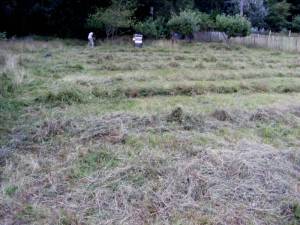 The drawknife is one of my favourite tools. It might even be my favourite tool but that’s a hard choice to make.
The drawknife is one of my favourite tools. It might even be my favourite tool but that’s a hard choice to make.
Recent discussions with visitors at shows and on the bodgers forum made me realise that the drawknife and its usage tends to get overlooked. A great shame as it’s a very versatile and capable tool which can do much more than just prepare blanks for the polelathe.
I often get asked three questions at shows. Is that a spokeshave? Isn’t it dangerous using it towards yourself? and which way up should you use it?
 When I first joined the APT I was given well intentioned advice that I was using the knife the wrong way around and that I should use it with the bevel downwards (as in the first photo). It seems that most people within the APT use the knife bevel downards.
When I first joined the APT I was given well intentioned advice that I was using the knife the wrong way around and that I should use it with the bevel downwards (as in the first photo). It seems that most people within the APT use the knife bevel downards.
So I duly learnt to use it bevel downwards, but have found recently that I’ve tended back towards using it bevel edge upwards with the flat back of the blade against the wood.
With the bevel downwards it’s easy to shift quite large shavings. With the bevel edge upwards the back of the knife tends to lie flat on the wood allowing more delicate shaving. When using it this way, like a mortice chisel, its important that the back of the blade is flat with no bevel (small pitting within the flat surface won’t affect it in use).
 When I discussed this recently with Anthony Cooper, a broom maker and green woodworker in Plaistow for many decandes, I found that he invariably used the knife bevel upwards. It seems that in this part of Sussex, at least, the drawknife was traditionally used bevel upwards.
When I discussed this recently with Anthony Cooper, a broom maker and green woodworker in Plaistow for many decandes, I found that he invariably used the knife bevel upwards. It seems that in this part of Sussex, at least, the drawknife was traditionally used bevel upwards.
The handles on my knife are slightly angled so that it is comfortable with the bevel up or downwards. Some drawknives are designed to be used one way in which case the handles maybe set intentionally at an angle to the blade to reflect this. The large knife in the photo has a different set to the handles and is only comfortable using bevel upwards.
 Drawknives come in all shapes and sizes, from tiny to giant, curved and straight, reflecting their intended usage and also the method of manufacture.
Drawknives come in all shapes and sizes, from tiny to giant, curved and straight, reflecting their intended usage and also the method of manufacture.
The two knives here are curved in both directions. The upper knife is a heavy duty blacksmith made knife and designed for shaving the bark from large coppice poles on a break. We used it recently on the fence line strainers.
The smaller knife is a Marples knife where the carbon steel blade is welded to the back of the knife. These knives are of mass produced but of good quality. It’s not clear why the knife is slightly curved in shape. Does anyone know?
 When choosing a second hand drawknife you are looking for one that’s not been mistreated or led too hard a life. There is no a lot of meat left on the blade of this knife. If the carbon steel was welded onto the back of the blade then it may have been used up already, or if the blade has been ground badly it may have lost its temper. But somebody used it like this so there is a chance it may still be useful. I don’t know yet, it’s in the queue.
When choosing a second hand drawknife you are looking for one that’s not been mistreated or led too hard a life. There is no a lot of meat left on the blade of this knife. If the carbon steel was welded onto the back of the blade then it may have been used up already, or if the blade has been ground badly it may have lost its temper. But somebody used it like this so there is a chance it may still be useful. I don’t know yet, it’s in the queue.
 When looking for a good drawknife I was lucky enough to find my Gilpin at a car boot sale on a general tool stand. I got it for a bargain (£10) considering that it had the original boxwood handles, the bevel was in good condition and showed little signs of wear, more a treasured tool than a knackered one.
When looking for a good drawknife I was lucky enough to find my Gilpin at a car boot sale on a general tool stand. I got it for a bargain (£10) considering that it had the original boxwood handles, the bevel was in good condition and showed little signs of wear, more a treasured tool than a knackered one.
The odd chip on the edge of the bevel is not a problem in usage as there is 10 inches of blade and rarely more than 2 inches gets used, so it’s quite easy to use a different section of the blade to achieve a better finish.
There is a lot more to say about drawknives and their uses, but I will leave that for another day.





















































